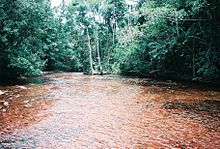Gran Sabana
The Gran Sabana is a 10,820 km² plateau in the southeast of Venezuela . It is enclosed by mountain ranges up to 1000 meters high. The area is characterized by wide and flat valleys and has a very old geological formation. The rocks of the earth's crust come from primeval earth times and formerly formed the western part of the Gondwana supercontinent .
Erosion fissured the sandstone masses over the course of millions of years . What remained are jagged valleys and huge, massive table mountains , which are called Tepuis in the language of the local Pemón Indians and whose age is estimated at 70 million years. The 115 different tepuis in this area are characterized by a unique and peculiar flora and fauna on their high plateaus. A large part of the animals and plants have developed into endemic species in the isolation that has lasted for millions of years .
The highest waterfalls in the world, such as Salto Kukenam and Salto Ángel, fall from the table mountains . The Salto Ángel is the highest known waterfall in the world with a drop of almost 1000 meters. It is also one of the most famous sights of the Canaima National Park , which has been declared a World Heritage Site by UNESCO . In the tepuis there are also spectacular cave systems such as the Muchimuk cave system in the Churí-Tepui , the Cueva Ojos de Cristal in the Roraima-Tepui or the shaft caves of the Sarisariñama-Tepui .
population
Most of the residents are pemones . They have their own language , which is one of the Carib languages . Most of the residents of the area also speak Spanish.
Web links
Coordinates: 6 ° 15 ′ 0 ″ N , 62 ° 50 ′ 18 ″ W.

